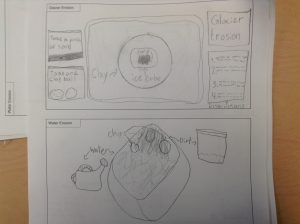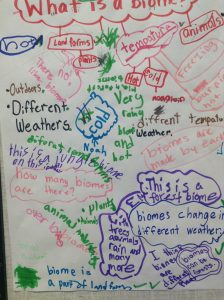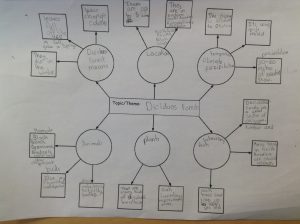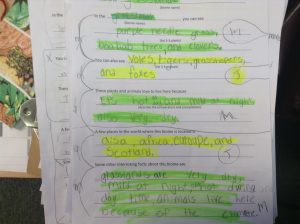Who am I as a developing professional?
My professional journey began long before I ever wanted to be a teacher. I began working with children as a teenager and learned how to interact with and teach children. I had a small understanding of the skills necessary to become a teacher such as caring for the well-being of students through various volunteer experiences. I studied Sociology and Education in my Bachelor’s degree with the intention of becoming a counselor. When I finished my degree I discovered that I no longer had the desire to pursue counselling. I still had a desire to work with children and I pursued a teacher’s assistant position working with a student with autism. I continued to build my professional knowledge by working closely with and observing the classroom teacher with whom I was working.
I believe a light bulb represents my professional learning journey because the moment that I chose  to be a teacher was a light bulb moment. My journey up to the moment that I chose to become a teacher was an “aha” moment. I realized one day that everything that I valued and cared about could be fulfilled through the teaching profession. The teaching journey involves constant learning and discoveries; however, many teachers experience bigger “aha” moments. I experienced a number of “aha” moments throughout my practicum that I built up to through the many little learning moments.
to be a teacher was a light bulb moment. My journey up to the moment that I chose to become a teacher was an “aha” moment. I realized one day that everything that I valued and cared about could be fulfilled through the teaching profession. The teaching journey involves constant learning and discoveries; however, many teachers experience bigger “aha” moments. I experienced a number of “aha” moments throughout my practicum that I built up to through the many little learning moments.
What are my educational commitments?
An important part of my classroom is hands-on, minds-on learning that involves supporting students in developing their own interests and pursuing their passions. Technology in the classroom is an important part of 21st century learning as students learn new skills to prepare them for a rapidly changing world. It is important for children to learn to be critical thinkers, global citizens, and cooperative learners. I chose an inquiry project based around technology to help pursue a topic based around technology and the well-being of my students.
I believe that all students are capable of learning and growing. All students have strengths and challenges and it is my job as an educator to work with my students to create a learning environment that will help them to succeed. I believe that student learning should be hands-on, engaging, and relateable. Learning should be engaging and relevant for students. I believe that it is important for students to find meaning in their learning and by finding meaning be responsible and invested in their learning. I believe that students deserve to be respected and valued as individuals, children, learners, and teachers. I believe in fostering good relationships with students, parents, and other educators are the key to a positive learning and teaching environment. I believe that students should be free to explore their passions and interests with guidance and support from their teacher. These beliefs are the driving force behind setting up my classroom climate.
The importance of critical thinking is something that I believe is important because I was encouraged to be a critical thinker as a student. Some of the skills of helping students to be critical thinkers are teaching good questioning techniques. Encouraging students to engage in class discussions and ask deep questions is an important part of engaging in critical thinking. Another important aspect of critical thinking is having students engage in inquiry projects. The importance of learning through inquiry was something I came to value through the teaching program. Engaging in my own inquiry project helped me to understand the vast learning opportunities that can come through asking deep questions.
Fostering good relationships with students, parents, and teachers is the foundation of any good classroom. Relationships are a central part of establishing respect and honesty. I hope to create a caring classroom environment which will differ based on the school community. In the future I will spend some time working in a faith based environment; therefore, my own personal faith will affect my classroom environment. Many of the values that I hold as a teacher are based in my faith and many will translate to any classroom environment. One of my greatest strengths is also my greatest struggle. Some of the values and beliefs that I hold will not be able to be expressed openly in the public school system. I know that one’s beliefs are impossible to completely separate from our teaching practice; however, one of my core beliefs is diversity of opinion. Even if my personal beliefs differ from my students or the school communities I will respect those beliefs.
My faith means that I value the importance of community and relationships. I believe that fostering good relationships and a sense of community is one of my strengths. A struggle based around this strength is that I am introverted. I struggle at times to interact with a large group, particularly when I do not know anyone. When I am at the front of a classroom I feel confident; however, I believe I will struggle to get to know the parents and teachers as quickly. I will continue to work on pushing myself to become a part of the community. What will my role be in my future communities? How diverse will those communities be? How accepted will I be? Will these communities be welcoming and will I be welcoming in return? These are many of the questions that I have about my upcoming teaching opportunities. Although I have many questions, I never want to let my struggles or questions limit from trying new opportunities. This is one reason why I hope to pursue teaching opportunities in the public and private systems as well as rural and international schools.
What have I learned from this year?
This year I learned to think through the eyes of a student. Before my practicum started I was thinking about my unit and lesson plans through the eyes of teaching and a teacher. As I began to teach and get to know my students my thinking shifted and I more and more saw my lessons through the eyes of a student. When I began to plan I had not been with my students for an extended period of time. I had begun to get to know them as students and people but I didn’t really know them that well. I planned all my lessons and units for people that I was trying to visualize. As I taught them on a daily basis and got to know them on a deeper, more personal level I realized the importance of relationships and understanding the diverse needs of students to be able to teach them.
Another important lesson I learned this year was the importance of flexibility. Sometimes things do not go exactly how I have planned or envisioned. I struggled during my practicum to let go of being in control of everything. I had to learn to both literally, leaving my written lesson plan somewhere where I couldn’t constantly check it, and figuratively, being okay with changes to the day, learn to let go. A part of learning to let go was seeing through the eyes of my students and realizing the need to adjust to fit their needs. Every day we should be learning and growing together and I make changes to our day and our lessons based on my student’s needs and interests. There are days when things don’t go well or a lesson flops but I always know that the next day is a fresh start and we can try it again tomorrow.
When I first chose my inquiry topic, I chose it with the intention of researching and discovering more about the benefits and downfalls of Fresh Grade. I quickly discovered that there is much more technology to be involved in formative assessment in the classroom. My main focus continued to be Fresh Grade; however, it was only one piece of the puzzle. My inquiry question was: How can technology enhance formative assessment? I anticipated that technology is becoming an important part of 21st century learning; however, I discovered through personal experiences, scholarly research, and discussions with colleagues just how impactful technology can be. My inquiry journey took me far beyond my initial expectations. It became an important part of my practicum and will continue to impact my teaching practice.
It is not a matter of if we will use technology for assessment but when and how. Formative assessment has proven to help increase student learning and as a result technology has begun to catch up in the classroom. There are many different tools for formative assessment that are now becoming available for school districts and they need to be taken advantage of. There are many types of apps that can then be translated into use on Fresh Grade. Students can easily share the pieces of work they have created on these different platforms on Fresh Grade.
Technology for assessment does not automatically mean students are engaged in the process. Technology can help students be more engaged in their learning when it is used in a way that considers students interests and needs. Students often love using technology and have a lot of knowledge about it. Teachers need to consider the audience or age group, the goal of the assessment, and the type of formative assessment when selecting engaging technology. Student’s learning is more visible than ever before through the use of technology and digital portfolios. Now students can share their excitement about learning on a platform that can travel with them from grade to grade.
Technology for assessment must be well thought out in order to be meaningful. Research has proven that technology can have a strong role in formative assessment so long as teachers are willing to search for the right technology and the right use. While technology can enhance formative assessment it cannot replace a good teacher who has strong pedagogical practices in place. It would seem that teachers are the key to technology enhancing formative assessment.
Technology is particularly important in formative assessment because it provides more open and immediate feedback. Using technology for formative assessment can provide open and immediate feedback in two ways. First, teachers can use quiz apps or exit slips posted to a website such as Padlet to instantly know if students have grasped a concept. With this real-time feedback the lesson can quickly be adjusted based on the information. Second, teachers, students, and parents all have access to student learning throughout the year on a tool like Fresh Grade. Every stakeholder can see a student’s achievements and areas where they are struggling. Students can set goals based on formative assessment before the summative assessment piece comes.
Technology helps students reflect on their journey as a learner throughout the year. Students often display a sense of pride and ownership when they use Fresh Grade. Fresh Grade provides a platform for children to develop their self-assessment skills. Through a careful, ongoing process the digital portfolios can help give evidence of student learning, show their learning journey, and invite students to reflect on their learning. Through writing, drawing, and video students can reflect quickly in real time providing an authentic look at their thoughts. Kelli Vogstad discusses the joy of watching her students using Fresh Grade stating, “It is exciting to watch and listen as students talk and write about what they did, and how they learned; what they struggled with, what was successful for them and how they know this is true. Through this language of reflection and analysis, students learn to monitor, assess, make decisions, and goals to move their learning forward (2015).”
Summative assessment is a key piece in using technology for formative assessment. While my inquiry project focused on formative assessment it has become clear to me that formative assessment is closely linked to summative assessment. Technology can help strengthen the process of student learning which has the potential to help them demonstrate their learning more clearly through summative assessment. This aspect of assessment is one that I will look forward to inquiring into in the future.
My inquiry question and discoveries became a very important part of my practicum and will continue to influence my teaching practice. The use of Fresh Grade was a big part of assessment in my classroom. In my practicum students posted evidence of their work on Fresh Grade. As well I used online concept maps and Padlet walls for conducting formative assessment. I discovered that self-reflection is an important part of formative assessment and student learning. I provided my students with many opportunities to engage in peer and self-assessment, often through Fresh Grade. I plan to continue to incorporate peer and self-assessment into my classroom even if technology is not available.
I used iPad’s and technology in the classroom on a weekly basis. Students were given opportunities to create projects using technology such as a biome video project and a math fraction book using Book Creator. Students set up their own blogs where they posted some of their learning and did a weekly writing assignment. The blogs were also a format for teaching students about internet safety.
I also used video recording in P.E. Originally I hoped to have students record one another performing a task, watch the video and assess for criteria. The purpose was to have students watch and then decide if they have met the criteria. If they had not met the criteria students would then be able to refilm. Once they were satisfied they had met the criteria they would write a self-reflection based on the video. I discovered that this did not match my student’s needs nor was it as practical as I had hoped. I had to change my strategy to use the technology to film my student’s performing the physical task. When I was in charge of the filming it compromised my classroom management. I discovered that while technology can be helpful to formative assessment in many ways, it also has its drawbacks. Teachers must be very intentional about how they use the technology. When I use technology, I will be constantly self-evaluating and checking with my students to make sure the technology is still meaningful in formative assessment. The goal of formative assessment should always be to help students learn and the use of technology is one powerful way this can be accomplished.
How will I continue to grow professionally?
I hope to continue to take advantage of as many professional learning opportunities as possible, particularly around the topics of inquiry, technology, and differentiation. I believe that these three topics are areas that I could continue to pursue for much of my teaching career. I believe that it is important to be open to a wide variety of teaching communities; therefore, I will continue to value the use of social media platforms such as Twitter to engage with various school districts, teachers, and other educators. I have discovered many great ideas through these platforms before and I believe technology is an important part of 21st century learning and teaching.
Another important part of my professional growth is to work on my turn my weaknesses into strengths as a teacher. For example, a weakness in my practice was my voice projection and control. I plan to repursue a passion of mine, singing, by joining a community choir. This past year I learned the importance of balance and taking care of one’s self especially during stressful times. Pursuing singing allows me to have activities beyond my career while helping me to work on my voice control which will help me in my classroom.
I will be working in both the public and private system and I will take advantage of professional development in both systems. I look forward to sharing some of knowledge about the revised curriculum with other colleagues and engaging in meaningful discussions and learning opportunities surrounding the revised curriculum. I have had a number of excellent professional development opportunities such as learning about inquiry, discussing technology with innovative educators, and exploring the revised curriculum. I believe there are other opportunities outside of the district or school for teachers to explore especially surrounding technology. Workshops provided by other groups such as a public library can be a great opportunity to get another perspective on an issue.




